Steps to recheck thermal paste for computer CPU
Usually, the error is caused by the old thermal paste between the CPU and the cooler that has dried.
Thankfully, it's not too difficult to re-apply the CPU thermal paste in a laptop or desktop computer. Read the following article to know how to check the CPU thermal paste.
Tools needed to apply thermal paste
Applying thermal paste is quite simple and can be done with available tools. However, since you are working with sensitive electronic components there is a risk of damage, so be sure to always follow the safety guidelines detailed in this manual.
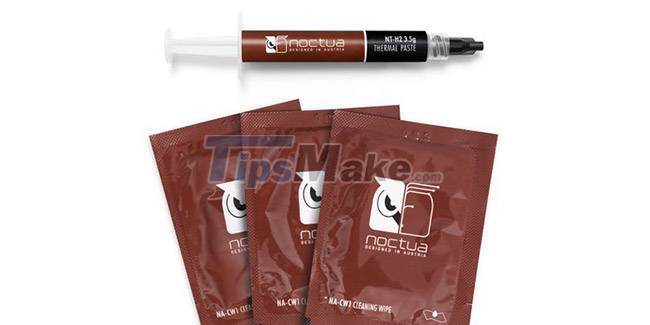
Tools needed include:
- Screwdriver.
- Anti-static wrist strap.
- Nitrile rubber gloves (powder-free).
- Isopropyl alcohol (purity 70% or higher).
- ESD wipes or coffee filter paper.
- Heat sink.
Steps to check CPU thermal paste
Step 1: Approach the area where the CPU cooler is located
Refer to the manual that came with your desktop or laptop computer to disassemble the chassis and access the CPU cooler location. Wear an antistatic wrist strap and when making sure it is grounded. Before continuing, don't forget to turn off your computer and disconnect all power cables.
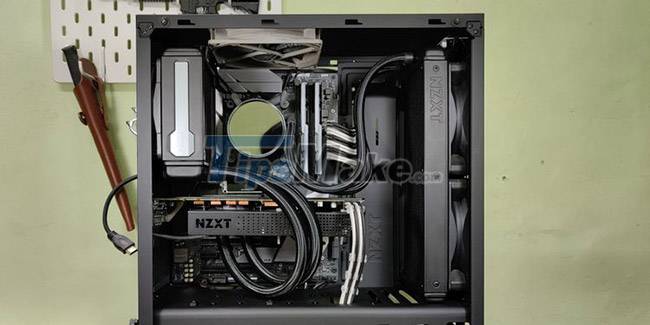
This is a fairly straightforward process for desktops with tower cases. Just unscrew all the screws to remove the left guard (when viewed from the front), then place the case on its side, preferably on a desk, for easy handling.
Laptop users should consult the manufacturer's manual to confirm the location of the screws and that the retaining tabs must be removed before accessing the interior. This varies greatly depending on the manufacturer and model of the laptop in use.
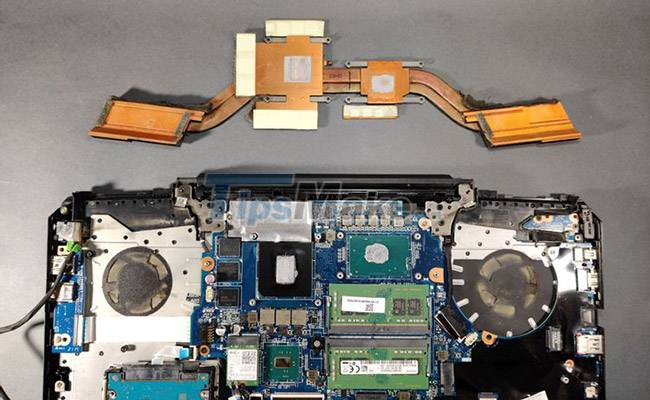
Some MacBooks and Microsoft Surface laptops are notoriously difficult to open. You can check out this excellent iFixit site here.
In case you can't find the manual for your particular laptop, chances are iFixit will have disassembly instructions for that laptop.
Step 2: Remove the CPU cooler
Desktop CPU coolers, either liquid or air cooled, are typically secured to the IHS CPU with 4 screws. Some CPU coolers may involve non-permanent motherboard racks and require special handling instructions. The article recommends that you refer to the CPU cooler assembly instructions to find the right disassembly method.
Laptop coolers also involve a very different number and placement of the screws that secure the heatsink on the CPU. Refer to the appropriate manual or the aforementioned iFixit laptop repair information archive for exact instructions regarding your laptop model and make.
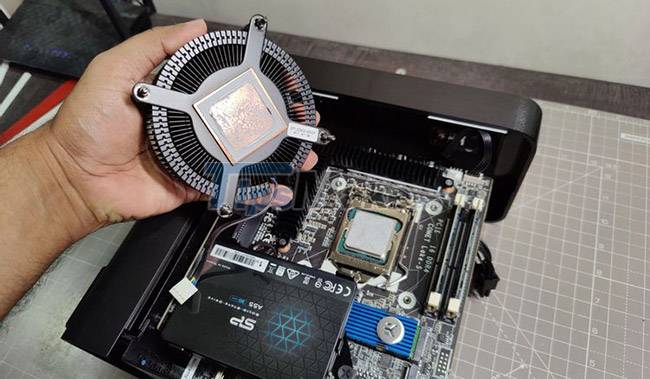
Regardless of the nature of the device, make sure you don't try to pull the CPU cooler away from the IHS. Start by turning the cooler slightly. This will make it easier to get the cooler out of the IHS CPU.
Do not apply excessive force if you feel the cooler is attached too tightly. In that case, the heatsink compound may have stuck too firmly to the CPU IHS. Using a blow dryer on the CPU will help melt the hard dry glue.
Step 3: Wipe off the old thermal paste
This is why you should wear powder-free nitrile rubber gloves to protect your skin from toxic heat glue. Gloves also protect the IHS block and CPU from finger oil, which can reduce heat conduction.
Dab a little isopropyl alcohol (IPA) on an ESD wipe or clean coffee filter paper and proceed to wipe away any remaining thermal paste on both the IHS CPU and the copper block.
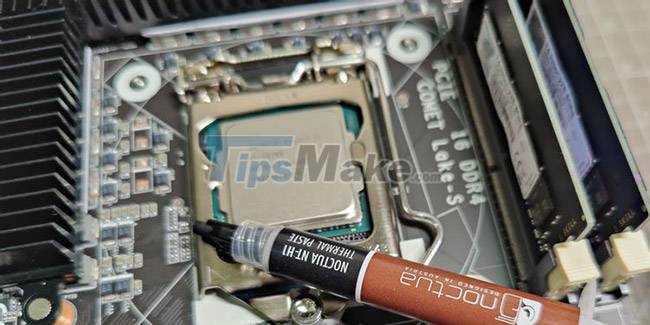
Make sure you don't use regular paper towels or cloths, as they can leave behind lint or dust. ESD wipes are a bit pricey, but they are best suited for this task. Coffee filter paper is the second best choice. It may not be as good as an ESD towel, but at least it won't leave paper residue on cleaned surfaces.
Continue to wipe the thermal paste with a new cleaning cloth until the cloth/paper is no longer discolored. If using 99% IPA, you don't have to wait too long before you can reapply the thermal paste. Lower concentrations of IPA will increase the waiting time.
Wait at least five minutes if you used a 70% purity IPA.
Step 4: Apply new thermal paste
The proper amount of thermal paste is a controversial topic in the PC hardware community. But there's one simple rule worth following: Avoid under-smudging the IHS CPU. Applying thermal paste too thin will create hot spots on the IHS, thus resulting in suboptimal cooling.
However, excess thermal paste is automatically removed when the CPU cooler is attached. That shouldn't be a problem if you're using a non-conductive one, so you should take extra care when injecting the glue in a cross, with small dots in between the quadrants, as shown in the illustration. below.
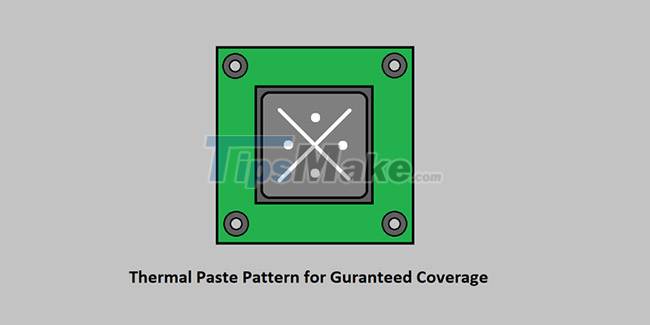
This is especially true for CPUs like the AMD Threadripper, as its unique chiplet design spreads the silicon over a much larger area than the IHS. On the other hand, the heat-generating silicon die in Intel processors is concentrated in the center and occupies only a small part of the total surface area of the IHS.
However, be warned if you must use conductive thermal paste. In this case, apply test glue and then install the CPU cooler. Next, remove the cooler to check for optimal coverage. Start over with adjusting the amount of glue if you experience spills or shortages, and clean the surface between each test application.
Repeat this process until you find the right amount of thermal paste required for optimal coverage. Do a final check with the right amount of thermal paste.
Step 5: Attach the CPU cooler
Follow the instructions provided in the manual to attach the CPU cooler to the IHS. In most cases this involves tightening 4 screws. However, it is important to tighten them in the correct order.
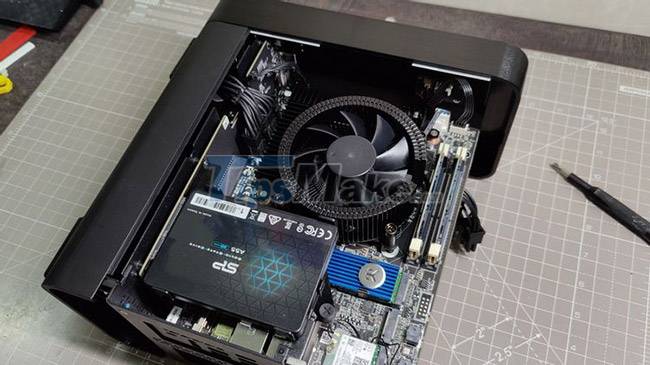
Start by positioning the copper block flat on the IHS CPU and turning each screw with your fingers. Do not fully tighten the screws at this joint.
Instead, slowly tighten the screws in the order shown in the image below. Repeat the process until all screws have been tightened.
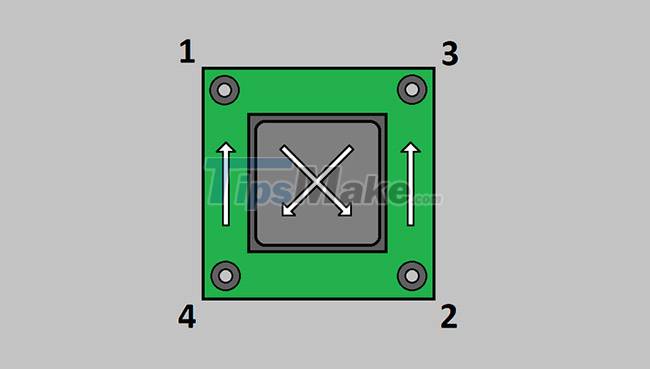
Following this procedure is important to ensure that uniform tightening is applied to the entire IHS CPU. Failure to do so results in uneven pressure, which can create hot spots that are detrimental to cooling performance.
Step 6: Reinsert the removed protective panels
Reverse the steps taken to disassemble the device and ensure that all screws are properly inserted and tightened. It's done! You have completed the necessary operations.
Confirm everything is fine
As a final step you need to confirm that the cooling system is working as intended. Download and install the free HWiNFO tool to verify if the CPU idle temperature exceeds ambient (room) temperature by 68°F (20°C) or more.
You can also use CPU benchmarks like Cinebench to evaluate CPU heat under synthetic load conditions. The HWiNFO tool also shows whether the CPU is overheated or reaching a critical temperature threshold during gaming.
If that happens, you have installed the wrong CPU cooler or it may not be suitable for your CPU. If your CPU's thermal performance is within the specification's allowable range, you've successfully re-applied the CPU thermal paste.
You should read it
- How to Apply Thermal Paste
- Using liquid metal instead of thermal paste, Asus laptops will be 10 to 20 degrees cooler than usual
- You have to use thermal paste properly?
- What does the hole in the back cover of some Intel CPUs do?
- 3 ways to prevent GPU Thermal Throttling
- Top 5 best heat sinks 2019
- How to copy and paste on Mac
- What is 'Thermal Throttling'?
May be interested
- 5 ways to fix computer errors that cannot Copy Paste
 copy and paste are basic functions that have been integrated by microsoft since the early days. join tipsmake to find 5 ways to fix the computer error of not being able to copy and paste.
copy and paste are basic functions that have been integrated by microsoft since the early days. join tipsmake to find 5 ways to fix the computer error of not being able to copy and paste. - How to Copy and Paste on Mac
 this article shows you how to copy and paste text or files on a mac computer. although the mac's built-in menu bar is often used to copy and paste data, you can still use your trackpad or keyboard to do this.
this article shows you how to copy and paste text or files on a mac computer. although the mac's built-in menu bar is often used to copy and paste data, you can still use your trackpad or keyboard to do this. - AR Cut & Paste - Application 'cut' real life objects 'paste' into Photoshop file
 ar cut & paste is an application that allows users to use the phone camera to capture objects and separate them from the background image and then 'paste' into documents on the computer in seconds.
ar cut & paste is an application that allows users to use the phone camera to capture objects and separate them from the background image and then 'paste' into documents on the computer in seconds. - Does the skin paste or decal make the laptop hotter than usual?
 will it be possible to increase the device temperature when using the skin or decal?
will it be possible to increase the device temperature when using the skin or decal? - How to Copy‐Paste Using Keyboard Shortcuts
 when you hear copy and paste, you might think of cutting and pasting in craft class, but copying and pasting on a computer or mobile device is different. using keyboard shortcuts to copy data and paste it elsewhere saves you time, and it's helpful if you know how to take advantage of your device's features. you can use some keyboard shortcuts to quickly copy and paste data to a new location to get the most out of your computer or phone.
when you hear copy and paste, you might think of cutting and pasting in craft class, but copying and pasting on a computer or mobile device is different. using keyboard shortcuts to copy data and paste it elsewhere saves you time, and it's helpful if you know how to take advantage of your device's features. you can use some keyboard shortcuts to quickly copy and paste data to a new location to get the most out of your computer or phone. - How to Copy and Paste on a Mac
 this wikihow teaches you how to copy and paste text or files on your mac computer. while your mac's built-in menu bar is the preferred way to copy and paste information, you can also use your mac's trackpad or keyboard to copy and paste....
this wikihow teaches you how to copy and paste text or files on your mac computer. while your mac's built-in menu bar is the preferred way to copy and paste information, you can also use your mac's trackpad or keyboard to copy and paste.... - What is 'Thermal Throttling'?
 like most devices that operate on electrical energy, computers will generate heat during use. however, depending on factors such as the duration of use or the way of use, the amount of heat generated is more or less.
like most devices that operate on electrical energy, computers will generate heat during use. however, depending on factors such as the duration of use or the way of use, the amount of heat generated is more or less. - You may soon be using Microsoft's Cortana to control the temperature
 microsoft cortana's voice assistant has just made a jump from computer and mobile to iot (everything connected).
microsoft cortana's voice assistant has just made a jump from computer and mobile to iot (everything connected). - How to Copy and Paste in Minecraft
 today's tipsmake will show you different ways to copy and paste in minecraft. as long as you are hosting or are an operator on a private minecraft server, and have the worldedit plugin installed, you will be able to copy and paste builds in one or all worlds. if you don't have server or worldedit access, the '/clone' command will help you copy and paste projects from one location to another. besides, you can also copy and paste text from the chat box or chat frame.
today's tipsmake will show you different ways to copy and paste in minecraft. as long as you are hosting or are an operator on a private minecraft server, and have the worldedit plugin installed, you will be able to copy and paste builds in one or all worlds. if you don't have server or worldedit access, the '/clone' command will help you copy and paste projects from one location to another. besides, you can also copy and paste text from the chat box or chat frame. - How to fix the error of not being able to copy and paste in Excel, Word
 the error of not being able to copy and paste in excel and word can interrupt your work. however, this problem can be quickly resolved if you follow the simple steps below.
the error of not being able to copy and paste in excel and word can interrupt your work. however, this problem can be quickly resolved if you follow the simple steps below.










 4 differences between wired mouse and wireless mouse
4 differences between wired mouse and wireless mouse How to choose the best fan case for your PC
How to choose the best fan case for your PC Causes of GPU overheating and how to fix it
Causes of GPU overheating and how to fix it NVIDIA releases DisplayID firmware update for GeForce RTX 3060 and 3080 Ti GPUs
NVIDIA releases DisplayID firmware update for GeForce RTX 3060 and 3080 Ti GPUs Review LG 27MP400 monitor: Spacious 27-inch size, 75Hz frequency, integrated FreeSync
Review LG 27MP400 monitor: Spacious 27-inch size, 75Hz frequency, integrated FreeSync Top 5 best Logitech gaming mice
Top 5 best Logitech gaming mice